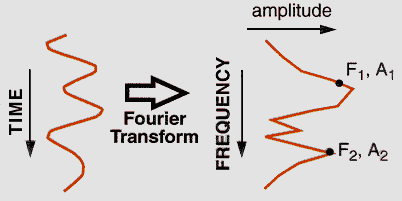|
... II. The Framework ...
values

 paradoxes
paradoxes
|
Mathematically the interference image on the film, or the hologram, is equivalent to transforming the three-dimensional
object into another mathematical domain, a domain called the frequency domain. In exploration geophysics, we routinely take time-series data, like a
reflection seismic wiggle trace, apply an FFT (Fast Fourier Transform), transforming the time domain wiggle trace into the
frequency domain (see Figure18).
There are many mathematical operations geophysicists perform in the frequency domain which are less compute intensive than working with the original
data in the travel-time domain. Once the mathematical operations are completed, we use the FFT to transform the processed data from the frequency
domain back to the time domain. The result is an improved seismic trace which more accurately represents the subsurface of the earth.

Figure 18. Fourier Attributes 2.13
The interesting characteristic of a holographic film related to a framework for science and religion is the fact
that if you cut the film into quarters, the entire image can be reconstructed from any one of the quarters of the hologram. The difference between
these reconstructions and a reconstruction made out of the entire holographic plate is a poorer resolution and a grainier image. In fact, the
holographic film can be cut into smaller and smaller pieces, and the entire image is in even the smallest piece of film. Again, the issue is the
resolution gets poorer the smaller the piece of holographic film. This reconstruction is possible because the interference pattern repeats,
like the Moiré patterns from two parallel snow fences.
The supposition is holography provide a common framework for science and religion because both
domains have the entire story embedded in subsets of their respective available data sets to some limited resolution.
|
timedex

 infinite grid
infinite grid
-054-
|